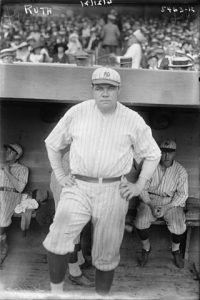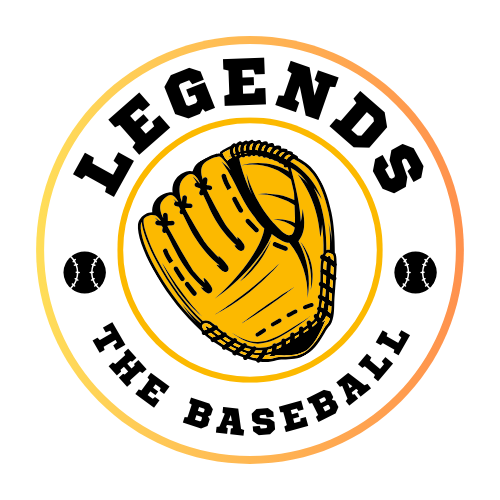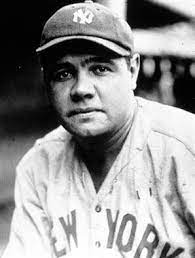George Herman “Babe” Ruth, Jr. (February 6, 1895 – August 16, 1948) was an American professional baseball player who played 22 seasons in Major League Baseball from 1914 to 1935. He played the outfielder and pitcher positions. Ruth (nicknamed “Bambino” and “the Sultan of Hitting”) began his career with the Boston Red Sox as a pitcher, but gained his greatest fame while playing for the New York Yankees as an outfielder. He set numerous MLB batting (and several pitching) records, including the most home runs of his career (714), slugging percentage (69.0 percent), runs batted in (RBIs) (2,213), base-on-balls (2,062) and on-base plus slugging (OPS) (1,164). His records for slugging percentage and OPS have yet to be surpassed by anyone else. Ruth was one of the first five baseball players inducted into the National Baseball Hall of Fame in 1936. President Donald Trump posthumously awarded him the Presidential Medal of Freedom.

Biography
Many details of Ruth’s childhood are unknown, including the date of his parents’ wedding. As a child, Ruth spoke German. When Ruth was a toddler, the family moved to 339 South Woodyer Street, near the train stations, and by the time he was six, his father had a saloon with an upstairs apartment at 426 West Camden Street. As an adult, Ruth admitted that as a young boy he ran around the streets and rarely attended school, and drank beer when his father wasn’t looking. According to some reports, after another incident at his father’s saloon, city officials decided that the environment was not suitable for a young child. On June 13, 1902, Ruth was sent to St. Mary’s Industrial School for Boys, run by the Brothers of St. Francis Xavier, where he was taught life lessons and baseball skills. He was recorded as “incorrigible” and spent most of the next 12 years there. Ruth was nicknamed “Niggerlips” because he had large facial features and was darker than most of the other boys in the correctional facility.
At the school, nearly half of the 850 wards had relatives who paid for their education. Children were sent to St. Mary’s from all over America, often the last hope when other schools could do nothing. Ruth was sometimes allowed to see his family or placed in the St. James home, a controlled residence with a job in the community, but he was always returned to St. Mary’s. He rarely visited his family; his mother died when he was 12, and he was reportedly only allowed to leave St. Mary’s to attend funerals.
Ruth was trained as a barber and tailor – many years later he would brag to his teammates about the professional skills he learned at that school. The mentors at St. Mary’s loved baseball. There were no fewer than forty-four teams in all at the school, and they all had equipment and uniforms. A great influence on Ruth at the school was his brother Matthias Boutillier, a descendant of French colonists from Cape Breton, Nova Scotia.
Ruth (top row, center) at St. Mary’s School for Boys in Baltimore, Maryland, 1912
The school left a special mark on Ruth’s upbringing. He was a lifelong Catholic and a prominent member of the Knights of Columbus. He attended orphanages, schools, and hospitals throughout his life, often avoiding publicity.
Most of the boys at St. Mary’s played baseball in organized leagues of varying skill levels. Ruth later estimated that he played about 200 games a year and steadily climbed the ladder of success. Ruth became a top pitcher at St. Mary’s and when he was 18 (in 1913) he was allowed to leave school to play weekend games. He was mentioned in several newspaper articles, both for his pitching prowess and his ability to hit home runs (home runs)
Sports career
In 1914 Babe signed with the Baltimore Orioles, one of baseball’s minor league clubs, but was soon sold to the Boston Red Sox. By 1916 Ruth had developed a reputation as an excellent pitcher who could sometimes hit a long-range home run, which was quite rare in those years. Although Ruth scored 23 wins a season twice as a pitcher and was a member of three Red Sox championship squads, he wanted to play every day and was allowed to move to the outfielder position. Soon after, Babe Ruth broke the MLB record for most home runs in a season, striking out 29 in 1919.
At the end of that season, Red Sox owner Harry Frazee sold Ruth to the New York Yankees for $100,000. Over the next 15 years in New York, Ruth helped the Yankees win seven American League titles and four World Series titles. His powerful hitting allowed him to break the record for most home runs hit in a season several times, which not only drew fans to the stadium and increased baseball’s popularity, but also changed strategy completely. In 1927, Ruth had one of the biggest accomplishments of his playing career, hitting 60 home runs in a season and surpassing his previous record. In 1935, Ruth transferred to the Boston Braves and ended his playing career at the end of the season. In 22 years in the MLB, he was the MLB leader in home runs hit in a season 12 times.
His legendary hitting power and charismatic personality made Ruth one of the most famous men of the Roaring Twenties. During his career, his accomplishments on and off the ballpark made him the subject of media and fan attention. His reckless lifestyle – his love of booze and women – was combined with a desire to do good, and he often visited children in hospitals and orphanages. After his playing career ended, he failed to find work in baseball largely because of his poor behavior during his MLB appearances. Toward the end of his life, Ruth often spoke to people, especially in support of the United States in World War II. In 1946 he was diagnosed with cancer and died two years later. Babe Ruth is considered one of the greatest sports heroes in American culture and one of the greatest baseball players in history.
In 1928 he made a cameo appearance in Harold Lloyd’s The Racer.
In 1992, Arthur Hiller directed the biographical film “Babe Was Only One,” starring John Goodman.

